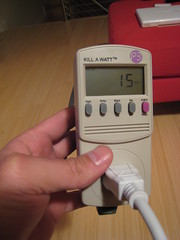The answer is definitely NOT:
World can halt fossil fuel use by 2090
- 12:13 27 October 2008
- NewScientist.com news service
- New Scientist staff and Reuters
The world could eliminate fossil fuel use by 2090, saving $18 trillion in future fuel costs and creating a $360 billion industry that provides half of the world’s electricity, the European Renewable Energy Council (EREC) and environmental group Greenpeace said on Monday.
The 210-page study [pdf] is one of few reports – even by lobby groups – to look in detail at how energy use would have to be overhauled to meet the toughest scenarios for curbing greenhouse gases outlined by the Intergovernmental Panel on Climate Change.
“Renewable energy could provide all global energy needs by 2090,” according to the study, entitled “Energy (R)evolution.” EREC represents renewable energy industries and trade and research associations in Europe.
A more radical scenario could eliminate coal use by 2050 if new power generation plants shifted quickly to renewables.
Solar power, biomass such as biofuels or wood, geothermal energy and wind could be the leading energies by 2090 in a shift from fossil fuels blamed by the IPCC for stoking global warming.
The total energy investments until 2030, the main period studied, would come to $14.7 trillion, according to the study. By contrast, the International Energy Agency (IEA), which advises rich nations, foresees energy investments of just $11.3 trillion to 2030, with a bigger stress on fossil fuels and nuclear power.
Rajendra Pachauri, head of the IPCC, which shared the 2007 Nobel Peace Prize with ex-US Vice President Al Gore, called Monday’s study “comprehensive and rigorous.”
Dangerous change
“Even those who may not agree with the analysis presented would, perhaps, benefit from a deep study of the underlying assumptions,” Pachauri wrote in a foreword to the report.
EREC and Greenpeace said a big energy shift was needed to avoid “dangerous” climate change, defined by the European Union and many environmental groups as a temperature rise of 2 degrees Celsius since before the Industrial Revolution.
The report urged measures such as a phase-out of subsidies for fossil fuels and nuclear energy, “cap and trade” systems for greenhouse gas emissions, legally binging targets for renewable energies and tough efficiency standards for buildings and vehicles.
The report said renewable energy markets were booming with turnover almost doubling in 2007 from 2006 to more than $70 billion. It said renewables could more than double their share of world energy supplies to 30% by 2030 and reach 50% by 2050.
:}
But it will only cost 17 trillion dollars:
http://www.itwire.com/content/view/21375/1066/
Sven Teske, with Greenpeace and co-author of the report, stated, “Unlike other energy scenarios that promote energy futures at the cost of the climate, our energy revolution scenario shows how to save money and maintain global economic development without fuelling catastrophic climate change.”Teske added, “All we need to kick start this plan is bold energy policy from world leaders.” [EREC]Teske concluded, “Strict efficiency standards make sound economic sense and dramatically slow down rising global energy demand. The energy saved in industrialised countries will make space for increased energy use in developing economies. With renewable energy growing four-fold not only in the electricity sector, but also in the heating and transport sectors, we can still cut the average carbon emissions per person from today?s four tonnes to around one tonne by 2050.” [EREC]
In the foreword to the report, Dr. Rajendra Pachauri wrote, “Even those who may not agree with the analysis presented would, perhaps, benefit from a deep study of the underlying assumptions,” [EREC]
Dr. Pachauri, who is the head of the Intergovernmental Panel on Climate Change, shared the 2007 Nobel Peace Prize with former-U.S. Vice President Al Gore,
:}
For more links:
http://www.reuters.com/article/environmentNews/idUSTRE49Q2I820081027


